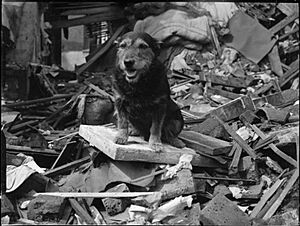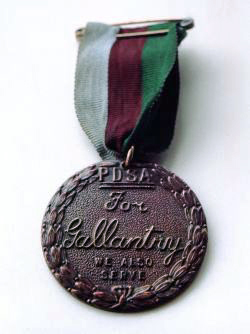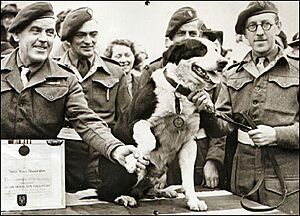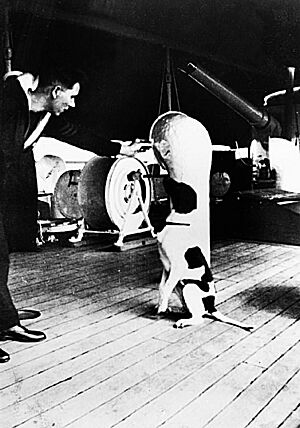Dickin Medal facts for kids
The PDSA Dickin Medal is a special award given to animals. It was created in the United Kingdom in 1943 by a woman named Maria Dickin. At first, the award was meant to honor animals who showed great bravery during World War II. Many people call it "the animals' Victoria Cross" because it's such a high honor.
Maria Dickin also started the People's Dispensary for Sick Animals (PDSA), which is a British veterinary charity. She created the medal for any animal that showed "obvious bravery" and dedication while helping the United Kingdom's armed forces or their allies. Between 1943 and 1949, the medal was given 54 times. It went to 32 pigeons, 18 dogs, three horses, and one cat.
Contents
The Dickin Medal: Honoring Animal Heroes
What is the Dickin Medal?
The Dickin Medal is like the highest honor for animals who serve in wars or other dangerous situations. It recognizes their amazing courage and loyalty. It was started to make sure these animal heroes were never forgotten.
A History of Bravery
The PDSA started giving out the Dickin Medal again in the year 2000. That year, they honored a Newfoundland dog named Gander. He received the award after his death (posthumously). Gander had saved the lives of Canadian soldiers during the Battle of Hong Kong in World War II.
Modern-Day Heroes
In early 2002, three dogs were given the Dickin Medal for their brave work after the September 11 attacks in the United States. The PDSA also honored two dogs who served with the British military in Bosnia and Herzegovina and Iraq.
In December 2007, 12 animals who had received the Dickin Medal and were buried at the PDSA Animal Cemetery in Ilford, England, were given full military honors. This happened after a project to fix up the cemetery, which was helped by the United Kingdom's National Lottery.
The very first animals to get the medal in December 1943 were three pigeons. They served with the Royal Air Force and helped rescue air crew from planes that crashed into the sea during World War II. The most recent animal to receive the medal was Diesel, a dog who was killed while working with the French police during the November 2015 Paris attacks. As of December 2015, the Dickin Medal has been awarded 66 times.
Amazing Animal Recipients
Brave Pigeons
For thousands of years, homing pigeons have been used to carry messages over long distances. They can find their way home from far away, which made them perfect for sending secret messages during wars. For example, pilots could carry pigeons in their planes. If a plane crashed, the airmen could release a pigeon with a message saying where they were. The pigeon would fly back to a military base, telling the military where to find the stranded pilots.
The United Kingdom used about 250,000 homing pigeons in World War II. Out of these, 32 were awarded the Dickin Medal for carrying messages that helped save lives.
| Recipient(s) | Date of award | Notes |
|---|---|---|
| White Vision | 2 December 1943 | Delivered a message that helped rescue a ditched aircrew. |
| Winkie | 2 December 1943 | Delivered a message that helped rescue a ditched aircrew. |
| Tyke | 2 December 1943 | Delivered a message that helped rescue a ditched aircrew. |
| Beach Comber | 1 September 1944 | Brought the first news of an Allied raid on Dieppe, France; served with the Canadian Army. |
| Gustav | 1 September 1944 | Brought the first message from the Normandy invasion on D-Day. |
| Paddy | 1 September 1944 | Brought a message from the Normandy invasion faster than any other pigeon. |
| Kenley Lass | March 1945 | First pigeon to deliver military intelligence from a secret agent in France. |
| Navy Blue | March 1945 | Delivered a message from a raiding party in France, even though he was injured. |
| Flying Dutchman | March 1945 | Delivered three messages from agents in the Netherlands. |
| Dutch Coast | March 1945 | Delivered an SOS message from a ditched aircrew, flying 288 miles in 7.5 hours. |
| Commando | March 1945 | Delivered three messages from agents in occupied France. |
| Royal Blue | March 1945 | First pigeon of the war to deliver a message from a plane that crashed in Europe. |
| Ruhr Express | May 1945 | Carried an important message from the Ruhr Pocket, a major battle in Germany. |
| William of Orange | May 1945 | The fastest pigeon to deliver a message from Operation Market Garden. |
| Scotch Lass | June 1945 | Brought 38 small photographs across the North Sea from the Netherlands, even though she was injured. |
| Billy | August 1945 | Delivered a message from a bomber which had been forced to land. |
| Broad Arrow | October 1945 | Brought three important messages from Europe to the United Kingdom. |
| NPS.42.NS.2780 | October 1945 | Brought three important messages from Europe to the U.K. |
| NPS.42.NS.7524 | October 1945 | Brought three important messages from Europe to the U.K. |
| Maquis | October 1945 | Brought three important messages from Europe to the U.K. |
| Mary of Exeter | November 1945 | Showed "outstanding endurance [in] war service" even though she was injured. |
| Tommy | February 1946 | Delivered a message from the Netherlands to Lancashire. |
| All Alone | February 1946 | Delivered an important message, flying over 400 miles in one day. |
| Princess | May 1946 | Flew a special mission bringing important information to Crete, flying more than 500 miles over sea. |
| Mercury | August 1946 | Did a special job that required a 480-mile flight from Northern Denmark. |
| NURP.38.BPC.6 | August 1946 | Made three flights in 1941. |
| G.I. Joe | August 1946 | Flew 20 miles in 20 minutes to deliver a message which saved over 100 lives. |
| Cologne | 1947 | Flew "home" to deliver a message from a crashed airplane over Cologne, even though he was injured. |
| Duke of Normandy | 8 January 1947 | The first pigeon to bring a message from Paratroops on D-Day. |
| NURP.43.CC.1418 | 8 January 1947 | The fastest pigeon to carry a message to the U.K. from the British 6th Airborne Division at Normandy. |
| DD.43.T.139 | February 1947 | Brought a message from a sinking ship in the Huon Gulf in time to save it and its cargo. |
| DD.43.Q.879 | February 1947 | The only survivor of three pigeons released to warn of a coming attack on Manus Island in Papua New Guinea. |
Heroic Horses
Horses have been used in wars for over 5,000 years. By World War II, they were not usually used in direct battle. However, they were still very important for scout units, and also to carry soldiers and supplies.
| Recipient(s) | Date of award | Notes |
|---|---|---|
| Olga | 11 April 1947 | Controlled traffic and helped with rescue operations after a flying bomb exploded in South London; served with the U.K. police. |
| Upstart | 11 April 1947 | Controlled traffic after a flying bomb exploded in Bethnal Green, Greater London; served with the U.K. police. |
| Regal | 11 April 1947 | Stayed calm in stable fires caused by fire bombs, on two separate occasions. |
| Warrior | 2 September 2014 | Honorary award to a World War I warhorse to honor the contributions of all animals during that war. |
Courageous Dogs

| Recipient(s) | Date of award | Notes |
|---|---|---|
| Bob | 24 March 1944 | A mongrel who worked on patrol in North Africa. |
| Rip | 1945 | A mongrel who found many trapped victims of The Blitz, when Nazi Germany bombed the United Kingdom. |
| Jet | 12 January 1945 | A German Shepherd who helped rescue people trapped under bombed buildings. |
| Irma | 12 January 1945 | A German Shepherd who helped rescue people trapped under bombed buildings. |
| Beauty | 12 January 1945 | A Wire-haired Terrier who helped find buried victims of The Blitz. |
| Rob | 22 January 1945 | A Collie who made over 20 parachute jumps during fighting in North Africa. |
| Thorn | 2 March 1945 | A German Shepherd who found bombing victims in a burning building. |
| Rifleman Khan | 27 March 1945 | A German Shepherd who rescued a soldier from drowning under heavy shell fire. |
| Rex | April 1945 | A German Shepherd who found bombing victims in burning buildings. |
| Sheila | 2 July 1945 | A Collie who helped rescue four American airmen lost in a blizzard after their plane crashed. |
| Peter | November 1945 | A Collie who found bombing victims trapped in burning buildings. |
| Judy | May 1946 | A pedigree Pointer who helped keep morale high among fellow prisoners in a Japanese prisoner of war camp. |
| Punch and Judy | November 1946 | Two Boxers who saved two British officers in Palestine by attacking an attacker. |
| Ricky | 29 March 1947 | A Welsh Collie who found mines along a canal bank, even though he was injured by one. |
| Bing (Brian) | 29 March 1947 | A German Shepherd who parachuted into Normandy with the U.K.'s 13th Battalion. |
| Antis | 28 January 1949 | A German Shepherd who served with a Czech airman and helped his master escape. |
| Tich | 1 July 1949 | A mongrel awarded for his "courage and devotion" between 1941–45. |
| Gander | 27 October 2000 | A Newfoundland who saved Canadian soldiers multiple times and was killed in action gathering a grenade. |
| Appollo | 5 March 2002 | A German Shepherd who received the medal in honor of all search and rescue dogs from the September 11 attacks. |
| Salty and Roselle | 5 March 2002 | Two Labrador Retriever guide dogs who led their blind owners down over 70 flights of stairs to escape the World Trade Center after the September 11 attacks. |
| Sam | 14 January 2003 | A German Shepherd who stopped an armed man and held back rioters while serving in Bosnia and Herzegovina. |
| Buster | 9 December 2003 | An English Springer Spaniel who found a weapons arsenal in Southern Iraq. |
| Lucky | 6 February 2007 | A German Shepherd who was the only survivor of a four-dog team tracking nationalists in Malaya. |
| Sadie | 6 February 2007 | A Labrador Retriever who found bombs that soldiers were able to disarm, while serving in Kabul, Afghanistan. |
| Treo | 24 February 2010 | A Labrador-Spaniel mix who found improvised explosive devices (IEDs) while serving in Afghanistan. |
| Theo | 25 October 2012 | A Springer Spaniel who found 14 IEDs in Afghanistan, the most ever found by a search dog. He died after his handler was killed. |
| Sasha | 29 April 2014 | A Labrador who found 15 mortars, mines, IEDs, and weapons in Afghanistan. Sasha and her handler were killed by a rocket-propelled grenade. |
| Diesel | TBC | A Belgian Malinois police dog who was killed by suspected terrorists during the November 2015 attacks on Paris. |
Simon the Ship's Cat
See also: Famous Ship's Cats: Simon
| Recipient(s) | Date of award | Notes |
|---|---|---|
| Simon | August 1949 | Simon was the HMS Amethyst's ship's cat. He received the Dickin Medal after his death for "bravery under fire" during the Yangtze Incident. Even though he was injured, Simon helped keep up the spirits of the sailors and killed many rats. |
Related Pages
Images for kids
-
Bing the ParaDog displayed with his Dickin Medal at the Imperial War Museum Duxford
See also
 In Spanish: Medalla Dickin para niños
In Spanish: Medalla Dickin para niños








